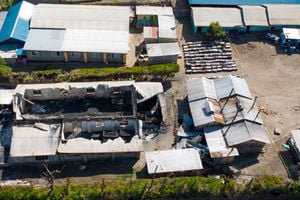Be ever ready to deal with disaster

A staff of Nakumatt watches in disbelief as the supermarket is engulfed in fire. Photo/FILE
Disasters and weather patterns have the potential to cause destruction and losses. Basic precautions an a disaster plan can prevent unnecessary loss of valuables and lives when a disaster strikes.
Disaster preparedness is a continuous process. It requires concerted efforts from everybody in the organisation. Natural hazards need not be natural disasters if both the public and government are well prepared to cope with them.
There are steps you can take within your organisation to protect your building and staff before it occurs. You need to establish security routines, including an annual building inspection and seasonal maintenance.
This includes regular inspection of electrical wiring, roofs and drains, fire alarms and smoke detectors. Fire extinguishers and sprinkler system are strongly recommended for personal safety, and there should be a map in the organisation showing their locations.
It is also advisable to establish and practice regular fire (drills), evacuation and earth quake/tremor response procedures. Map out evacuation routes, designated shelters and assembly points.
Installation of alarms to prevent intrusion, deliberate, or random violence, emergency lighting, and prohibiting smoking within the buildings, especially storage areas prevents fire breakouts.
Organisations are encouraged to check insurance coverage validity to make sure assets and resources are insured. Determine how you will have access to emergency funds: a supply of purchase orders to be used during emergency, or a disaster emergency fund.
Train staff in salvage techniques. Label vital records, and create an inventory or locator map that will allow you quick access to these records when needed. Regularly update your finding aids and keep copies or records off-site.
Keep duplicates of your disaster plan, policies, lists, and record inventories off-site. A disaster plan will guide your organisation through the proper responses.
Organisations need a written disaster preparedness plan or policy, which includes risk assessment, disaster recovery, damage assessment, and post disaster evaluation procedures.
Involve everyone in management
It should identify and prioritise the most important records. This includes records needed to resume business and determine which record media are more vulnerable or valuable than others.
The plan should establish responses to all potential geographic and climatic hazards, and other risks that jeopardise employees, building, and storage: floods, fires, pest infestation, mould, vandalism and accidents. You should maintain contact with local authority offices to understand their disaster response procedures, identify sources of assistance, and develop contacts with appropriate consultants, suppliers, and vendors beforehand.
List names and telephone numbers of all important contacts. Update the list whenever there is any change(s). Special conservation efforts may be necessary with water or fire-damaged records, have phone numbers and addresses available of people or agencies to contact. Create a telephone tree of staff and volunteers to help in the event of a disaster.
All staff should know who they report to, and who they notify in case of disaster. You should also know what your insurance carrier will require as evidence of damage: photographs, written documentation, samples of damaged items, recorded interviews, etc. There is also a need to establish salvage procedures for all items, records, paper, and record media.
There must be clear roles and responsibilities in approach to disaster response: damage assessment and damage recovery must be spelt very clearly.
These personnel will include caretaker responsible for seeing that the building is safe; loss assessor to organise and manage the process by which damage is evaluated; floor warden to check individual and team response and recovery manager.
During recovery always place human safety first. In the event of an emergency, prevent staff and volunteers from entering the building until local authority and government officials (fire, rescue, police, military personnel, etc.) or a building inspector determines the building safe to enter.
Allow only authorised staff and volunteers into the damaged area, use check-in/out sheets to monitor access. Three key points to reducing risks of natural disasters are: Anticipating, Education and Informing.
Julius Ogony is a lecturer and disaster preparedness specialist




